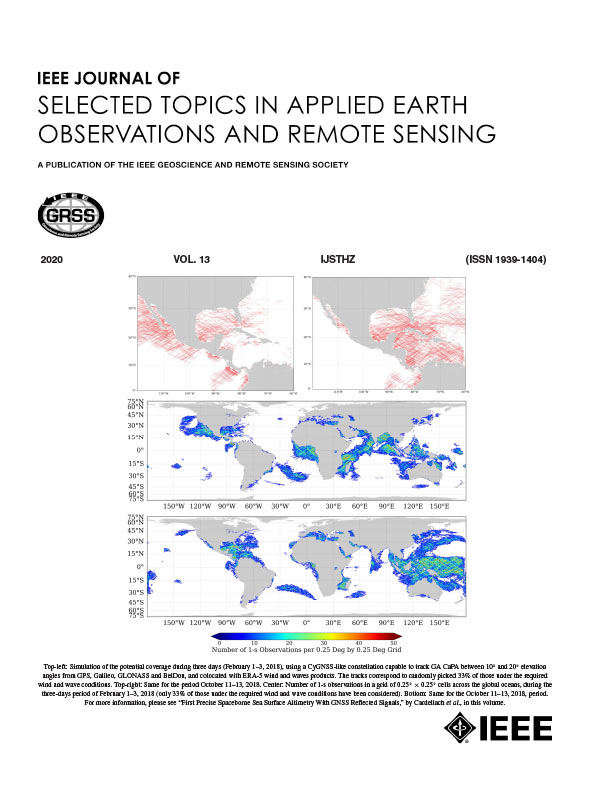基于 GRACE 空间约束的全球导航卫星系统陆地蓄水反演方法
IF 4.7
2区 地球科学
Q1 ENGINEERING, ELECTRICAL & ELECTRONIC
IEEE Journal of Selected Topics in Applied Earth Observations and Remote Sensing
Pub Date : 2024-09-03
DOI:10.1109/JSTARS.2024.3454312
引用次数: 0
摘要
在利用全球导航卫星系统(GNSS)观测数据进行陆地蓄水(TWS)反演时,拉普拉斯平滑算子用于约束目标网格与邻近网格之间的关系。我们利用重力恢复和气候实验(GRACE)数据中的先验空间约束,对 GNSS TWS 反演中使用的平滑约束矩阵提出了改进建议,并反演了四川-云南地区 TWS 变化的 GNSS 垂直位移数据。我们重点反演了四川-云南地区 2013 年 1 月至 2023 年 6 月的多年季节性 TWS 变化,整合了 GNSS、GRACE 和全球陆地数据同化系统(GLDAS)数据。我们的研究结果表明,GNSS推算的TWS与GRACE和GLDAS数据的时空模式具有一致性。通过比较带有平滑约束的估计结果,利用 GRACE 约束的拟议 GNSS 反演增强了对局部 TWS 信号的捕捉,提高了与 GRACE 和 GLDAS 的空间一致性。与 GRACE 的相关系数从 0.655 提高到 0.723,与 GLDAS 的相关系数从 0.730 提高到 0.779。我们进一步整合了四川-云南降水、径流和蒸散的水平衡方程,通过与已有数据集的比对验证了我们的方法,并提高了对 TWS 动态的空间理解。这些改进强调了我们的全球导航卫星系统反演策略在 GRACE 空间约束条件下的有效性,并使我们能够对全球导航卫星系统衍生的 TWS 变化做出更一致、更有意义的解释。本文章由计算机程序翻译,如有差异,请以英文原文为准。
A GNSS Terrestrial Water Storage Inversion Method Based on GRACE Spatial Constraints
The Laplace smoothing operator is used to constrain the relationship between the target grid and neighboring grids in the terrestrial water storage (TWS) inversion using global navigation satellite system (GNSS) observations. We propose an enhancement to the smoothing constraint matrix used in GNSS TWS inversion with prior spatial constraints from gravity recovery and climate experiment (GRACE) data and invert vertical GNSS displacement data for TWS changes in the Sichuan–Yunnan region. We focus on inverting multiyear seasonal TWS changes in the Sichuan–Yunnan region from January 2013 to June 2023, integrating GNSS, GRACE, and global land data assimilation system (GLDAS) data. Our findings demonstrate the consistency of spatiotemporal patterns between GNSS-inferred TWS and GRACE and GLDAS data. Comparing the estimated results with smoothing constraints, the proposed GNSS inversion utilizing the GRACE constraint enhances the capture of local TWS signals, improving spatial agreement with GRACE and GLDAS. The correlation coefficient with GRACE improves from 0.655 to 0.723, and with GLDAS, it improves from 0.730 to 0.779. We further integrate water balance equations for precipitation, runoff, and evapotranspiration in the Sichuan–Yunnan, validating our approach by aligning with established datasets and improving the spatial understanding of TWS dynamics. These enhancements underscore the effectiveness of our GNSS inversion strategy under the spatial constraint of GRACE and enable a more coherent and meaningful interpretation of GNSS-derived TWS changes.
求助全文
通过发布文献求助,成功后即可免费获取论文全文。
去求助
来源期刊
CiteScore
9.30
自引率
10.90%
发文量
563
审稿时长
4.7 months
期刊介绍:
The IEEE Journal of Selected Topics in Applied Earth Observations and Remote Sensing addresses the growing field of applications in Earth observations and remote sensing, and also provides a venue for the rapidly expanding special issues that are being sponsored by the IEEE Geosciences and Remote Sensing Society. The journal draws upon the experience of the highly successful “IEEE Transactions on Geoscience and Remote Sensing” and provide a complementary medium for the wide range of topics in applied earth observations. The ‘Applications’ areas encompasses the societal benefit areas of the Global Earth Observations Systems of Systems (GEOSS) program. Through deliberations over two years, ministers from 50 countries agreed to identify nine areas where Earth observation could positively impact the quality of life and health of their respective countries. Some of these are areas not traditionally addressed in the IEEE context. These include biodiversity, health and climate. Yet it is the skill sets of IEEE members, in areas such as observations, communications, computers, signal processing, standards and ocean engineering, that form the technical underpinnings of GEOSS. Thus, the Journal attracts a broad range of interests that serves both present members in new ways and expands the IEEE visibility into new areas.

 求助内容:
求助内容: 应助结果提醒方式:
应助结果提醒方式:


